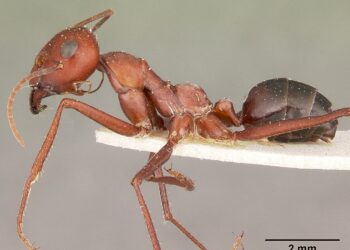Having a smart strategy doesn’t require a brain, a new study has shown. Researchers found an insect-eating plant from Borneo which can outsmart ants and temporarily turn off its trap to attract more prey.

Carnivorous plants are plants that derive some or most of their nutrients (but not energy) from trapping and consuming animals or protozoans, typically insects and arthropods. They still photosynthesize, but they also like a tasty snack once in a while. The Asian carnivorous species of plant from Borneo are called pitcher plants, due to their cup-shaped traps for the insects which resembles a pitcher. Pitcher plants can easily capture and trap ants due to the plant’s margins that become wet and very slippery. When the prey walks on the edges of the flower, it falls inside the cup and is trapped there. But this plant has developed a different strategy – instead of eating one ant at a time, it devised a strategy to eat more insects in one meal.
The plant can make its edge slippery or safe, and it does so depending on what it wants.
“The plant’s key trapping surface is extremely slippery when wet, but not when dry,” explained project leader Ulrike Bauer of Bristol University’s School of Biological Sciences. “For up to eight hours during dry days, these traps are ‘switched off’ and do not capture any of their insect visitors. At first sight, this is puzzling because natural selection should favor traps that catch as many insects as possible.”
The thing is, ants don’t all march in at once – they have individual scouts that go ahead and see if a route is safe. If the scouts find that the plant’s edge is not slippery, they come in with nectar. Pretty soon, the ants will return in bigger numbers to retrieve more nectar, but they will have a sad surprise – the edge of the plant has become slippery again, trapping many of them in one go. So the plant chooses to let the scouts go and lure in more ants to feast upon. The plant’s strategy appears to be extremely successful, biologists report.
“Of course a plant is not clever in the human sense – it cannot plot. However, natural selection is very relentless and will only reward the most successful strategies,” said biologist Ulrike Bauer of Britain’s University of Bristol, who led the study being published on Wednesday in the scientific journal Proceedings of the Royal Society B.
However, what may seem like a win for the plant may actually be a case of mutual advantage. The plant gives away some of its nectar in exchange for some ants, and while it’s not clear yet, this may be beneficial for the ant colony.
“By ‘switching off’ their traps for part of the day, pitcher plants ensure that scout ants can return safely to the colony and recruit nest-mates to the trap,” Bauer said. “Later, when the pitcher becomes wet, these followers get caught in one sweep. What looks like a disadvantage at first sight, turns out to be a clever strategy to exploit the recruitment behavior of social insects.”
Carnivorous plants are usually found in nutrient-poor environment, which is why they need to compliment their diet. Foraging, flying or crawling insects such as flies are attracted to the cavity formed by the cupped leaf, often by visual lures and nectar bribes.






